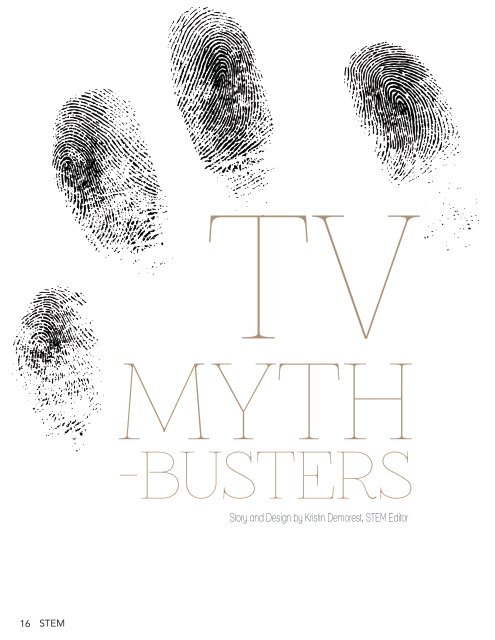Valkyrie Fall 2018 - Issue 1
You also want an ePaper? Increase the reach of your titles
YUMPU automatically turns print PDFs into web optimized ePapers that Google loves.
TV<br />
MYTH<br />
-BUSTERS<br />
Story and Design by Kristin Demorest, STEM Editor<br />
Chances are, in this age of<br />
streaming galore, everyone of<br />
us has binge-watched at least<br />
one TV show with some plotline<br />
about ground-breaking, state<br />
of the art, scientific innovation.<br />
Whether it’s “Grey’s Anatomy”<br />
on Netflix, “CSI” on Hulu, or<br />
even the classic “Breaking Bad,”<br />
we’ve sat on the edge of our seats<br />
wondering what medical mystery<br />
or serial killer case they can solve<br />
through good old-fashioned science.<br />
While these scenes are riveting,<br />
and seem like they really<br />
could happen or actually have<br />
happened, have you ever wondered<br />
to yourself if it is real?<br />
We all do. Most of the scenes<br />
that take place on these shows are<br />
based off of in-depth research<br />
by the producers to make the<br />
shows realistic and suspenseful;<br />
however, it would be naive not to<br />
ignore the fact that these shows<br />
can be slightly exaggerated or<br />
downright ludicrous from time<br />
to time. We’ve investigated a few<br />
of these whirlwind, award-winning<br />
TV shows, and found a few<br />
things that might have tricked<br />
viewers but would never happen<br />
in real life.<br />
Take for instance, “Grey’s<br />
Anatomy.” This critically<br />
acclaimed drama has been on<br />
for 15 seasons, exploring many<br />
difficult and controversial topics<br />
throughout its many seasons.<br />
Though much thought and<br />
research has been put into making<br />
all of the patient cases feasible,<br />
in an interview with the magazine<br />
The Closer, director Shonda<br />
Rhimes said, “Although we’re<br />
sure many of the things that go<br />
on in the show don’t really happen,<br />
like hooking up in call rooms<br />
and trauma procedures, overall<br />
“Grey’s” goes to great lengths<br />
to make it as medically accurate<br />
as possible.” One great example<br />
of this occurs very early in<br />
the show when the character Dr.<br />
Izzie Stevens cuts the wire to a<br />
heart device called a LVAD (Left<br />
Ventricular Assist Device), which<br />
was keeping a patient’s heart<br />
pumping because he had suffered<br />
from bad heart failure. In this<br />
particular episode, the doctor was<br />
trying to move the patient with<br />
the LVAD up on the heart transplant<br />
list, so she tried to make<br />
his heart fail by cutting off his<br />
assist device. The patient lived<br />
and did get a donor heart, and<br />
Dr. Stevens actually came back to<br />
the hospital after a short leave of<br />
absence. Long story short, there’s<br />
no way this could’ve happened. A<br />
medical student on an online discussion<br />
page said, “Because of<br />
Denny’s underlying condition,<br />
without the LVAD, he would go<br />
into severe heart failure.” The<br />
patient didn’t even receive the<br />
donor heart until about 17 hours<br />
later, and he would’ve died almost<br />
immediately. On top of that, Dr.<br />
Stevens would not only have been<br />
fired by the hospital, but would<br />
have had her medical license<br />
revoked immediately. This is just<br />
one of many crazy situations that<br />
was exciting to watch but would<br />
never occur in a real hospital.<br />
So, in sum, “Grey’s Anatomy:”<br />
busted.<br />
Another great example of a<br />
television show that is known<br />
for showcasing science is “CSI”<br />
is likely the show that started it<br />
all, spurring countless spinoffs in<br />
cities like Miami, New York, and<br />
Los Angeles. The show follows<br />
a team of nightshift crime scene<br />
detectives, while focusing on the<br />
scientific procedures that allow<br />
them to solve grueling murder<br />
mysteries. Every single episode<br />
involves them collecting evidence<br />
at crime scenes and linking it to<br />
a killer. Most of the techniques<br />
they use are accurate, although<br />
far-fetched, like collecting 1/8 of<br />
a fingerprint off of the counter<br />
and somehow finding a match for<br />
it, which is highly unlikely. There<br />
are many exaggerated scenes like<br />
this, but even more than that there<br />
is a general misconception with<br />
the entire plot of the show; crime<br />
scene investigators and police are<br />
not the same. The law enforcement<br />
who interrogate suspects<br />
and make arrests are not the same<br />
people who work in the lab and<br />
run DNA tests. They don’t have<br />
any of the same training. Being a<br />
crime scene investigator requires<br />
a background in genetics, chemistry,<br />
biology or some other discipline,<br />
while being a police officer<br />
requires a degree from the<br />
Police Academy. Not to say that<br />
someone couldn’t be certified to<br />
be both, but it would take a very<br />
long time and isn’t very likely.<br />
Not only this, but “CSI” typically<br />
shows a murder investigation<br />
solved within days, sometimes<br />
even within hours. The work it<br />
takes to run one DNA analysis is<br />
typically around five days, and the<br />
typical murder mystery in real<br />
life usually takes years to solve<br />
due to this extensive amount of<br />
time it takes to run these tests.<br />
It’s nearly impossible to solve a<br />
murder in less than a week unless<br />
you were to find the culprit<br />
standing over the body with the<br />
murder weapon in their hand. So<br />
while many of these episodes are<br />
thrilling, they’re unrealistic and<br />
wouldn’t happen in real life. So,<br />
“CSI:” busted.<br />
16 STEM<br />
17














